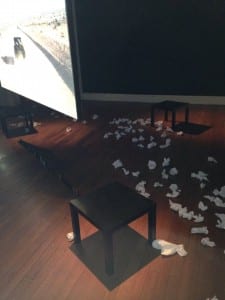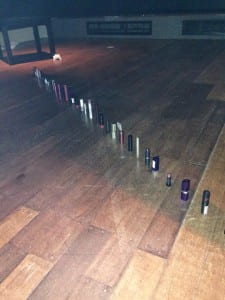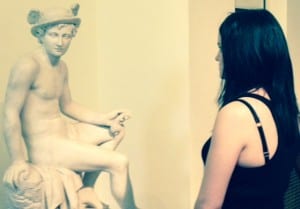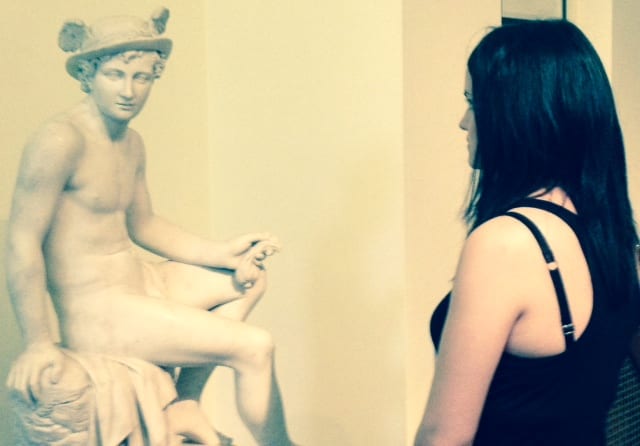Framing Statement
‘Voicing the Untold’ is the name Kirsty Rice, Morgan Wills and I chose for our Site Specific performance which entails a response to the artwork that had previously been displayed in Gallery 6 of The Usher and Collection.
In contemporary society, it is apparent that many galleries around the world are male dominated in the sense that most of the work exhibited are created by men. “Modernist art teachers accept that the female nude is a common theme in modernist art and that modernist artists are predominantly male.” (Emery 2002 p.30) In the Usher and Collection there was an exhibition in Gallery 6 called ‘Modern Masters’ which featured the work of such artists as Warhol, Matisse, Picasso and Dali. The exhibition had numerous drawings and sketches of women, many of which were done by these particular artists. Upon researching these artists and their works, we decided as a group for our final performance that we will create a performance based on the sketches that were in Gallery 6. What was brought to our attention was the fact it was very male dominated and a lot of the sketches were of only women, many of whom were naked.
Through a number of tasks we took part in over the weeks we liked the use of our own narratives, creating stories from the perspectives of the women who are displayed in the artwork in The Usher. At first, as a group we each individually created many textual responses from the artwork and we had given back a voice to the women being displayed, as many of these women were known as mere ‘figures’ and we wanted to voice their perspective on being a women who is the subject of artwork. However we decided we wanted to give our piece more depth and include proper published feminist work by women such as Helene Cixous and Lucy Irigaray. Upon research of these women we began to discover many appropriate and fitting writings that could be incorporated into our piece. “Distracted she is abstracted from us. He doesn’t paint great historical subjects , he paints thoughts (said a contemporary). He paints thoughtfulness…(Roger de Piles, 1699, Paris)The absence in the body. This leave taking by the soul that leaves the body deserted like a living tomb. We think : were parting from the picture.” (Cixous, 1998 p.17)
We also researched the group Guerrilla Girls who fight on bringing equality to artwork. They believe that there are not enough female artists being exhibited in galleries. Through looking at the work by groups such as Guerrilla Girls, it gave us inspiration towards our textual responses to the male dominated exhibit ‘Modern Masters’.
After practicing reading our script in two of the different galleries we decided that Gallery 6 was the most appropriate for our piece. It was where all the images of the women initially were and this is where we got our inspiration for the narratives from. This space is very intimate, with its all black plain walls. By the time our performance comes around all the artwork will be taken out the room which makes it even more fitting as it felt that the women in these pictures weren’t important and once they have been taken down, people can just forget about them. Even though the pictures cannot be seen on the day, it should be obvious through our script, what they might have looked like. “My body is exposed right in front of his gazing eyes, yet I do not see them beyond my guard. My arm is slung across my body protecting some of my naked figure and covering myself, only to leave it to his imagination.”
Our performance is exactly an hour long, we decided we didn’t want our performance to lose its importance and become too repetitive. We are going to perform twice during the day, once at 10-11am and again at 1-2pm, so that a variety of audience members could watch it as they were walking through the gallery.
It became apparent that an audience wasn’t necessarily crucial for our piece to have meaning or be thought provoking. With the way we are framing it and using the history and the knowledge the room held there before meant it was quite a powerful and intimate piece and audience members could stay in the room for just a minute and still understand what our intentions were. “[…]’the location can work as a potent mnemonic trigger; helping to evoke specific past times related to the place and time of performance and facilitating a negotiation between the meaning of those times’.” (Pearson, 2010 p. 9)
Process and Development
During our process we had little tasks to complete that we could do once we had arrived at the museum or we could have done some of the tasks beforehand – such as take note of 10 things that we had seen or smelt on the way to University during the week. “In this way the students learn to see a performance as something that resists categorization, something that is not-theatre, not-art, not-dance, not-film. Something, in other words, that allows you to do what you want. (Lavery, 2005 p.234)
One of my individual tasks was to find an artwork that showed noise. Once I went round the gallery and actually looked properly at the paintings, I imagined the fictional stories behind them through the context they were set in. The picture then began to come alive and I could imagine the “noise” coming from it. One piece of artwork that stood out to me was one by Liz Kay (2009) I am a Woman – on the description next to the picture she had described women being like ‘circus performers’. The reason why I think the picture spoke noise was not only because there were clearly instruments on the collage but also the thought of the housewife juggling tasks such as making breakfast with the television on in the background creates a loud chaotic atmosphere in my mind.
I think it was interesting that this piece was done by a woman and how she feels being a mother and a housewife seems, like a routine that is performed daily. Although the picture had bold bright colours, it seems appears to be negative in the sense that a woman is contracted to a performance everyday and had to endure the same daily routines and chores.
By doing this task it meant that I engaged more with the artwork in the museum and actually stood and read things in-depth and researched the background of some of the pieces – something I definitely would not have done if I was just going to a museum for a social or casual aspect. This then branched a few ideas that me and my group started to explore about the fact that people just stand and look at pieces of artwork in the museum for a couples of minutes and then move onto the next, not really engaging and asking questions about the piece or wondering the context and reasons for them to be there. So we found it would be interesting to create a piece that people actually stand and question why it is there and its message or importance in doing so instead of just accepting something that has been chosen by a curator.
During the process we came up with many ideas that we thought would be good to do at the site. However after visiting the museum more and more we finally came up with an idea for our final performance which has come to light through the individual tasks we have taken part in over the process in the last few weeks.
Another one of our tasks was to find an artwork that we liked then once we had found a particular piece we had to consider the ‘performance’ of the characters inside the image. We were able to do a rant a manifesto to the contemporary, or a letter to ‘art’. Myself, Morgan and Kirsty all found pictures that were about women, in particular, our group made textual responses to Henry Matisse’s artwork of the naked woman, also Austin Garland’s – The woman in a Kimono and Liz Kay’s – I am a woman. I particularly came up with a poem.
Liz Kay’s work, which I initially focused on showed women’s everyday life as being that of a circus performer, it wasn’t portraying the positive connotations you associate with being a mother and a wife, and the lexis used on the poster demonstrated the negative aspect of being a woman. Such as doing the chores, feeding ‘the’ baby, starting all over again, it feels as if the woman is detached from her own home and family, and just doing it to keep things running – like a circus performer.
We each then brought this together our responses and presented our short performance in Gallery 6 – the room where there were a large number of naked women on display. It suited what we were doing very well and enabled the audience to not only pay attention to the dialogue but also to focus on the figures in these pictures. “Performing the museum is a dialogic process, a play between the public narratives of the museum and the private narratives of viewers. To achieve this dynamic relationship requires an open, risk taking pedagogy on the part of the museum, one that enables viewers to turn history onto itself and to interrogate its ideological terrain“(Garoian,2001 p.239).
The artist who created these pieces of art may not have had the same intention or narrative behind their work, however people can interpret things in different ways and in this instance we each saw the female body portrayed in a way which exposes her for the purpose of ‘art’. “Viewers’ personal narratives represent speaking in the first person, acting out one’s subjective knowledge, which is contrary to the third person narratives that are constructed by the museum that speak for the viewer“(Garoian 2001 p.241). The public who see our performance may not agree with what we are saying, however it may make them realise that they do not have to accept what the curators say about a particular piece of artwork, it is open for interpretation.
Influences
To develop our piece more we have decided to introduce works of other feminist writers such as Luce Irigaray, Julia Kristeva, and Helene Cixous. This will enable us to view how other writers talk about women in their work but also some of their writing may be able to be incorporated into ours which will also be part of our dialogue on the day.
I looked into Helene Cixous’ work; she is a French feminist writer, a poet, playwright, philosopher and literary critic. “Books of Helene Cixous are an engagement with intimacy which sometimes explicitly, at others implicitly raises questions about the status of the subject: place and significance of literature and dreams in our lives “(Cooke 2011 p.3). Cixous uses her own life and its events as raw material and that is how her work is shaped. This creates intimacy for the reader and allows them to understand her as an author more as she uses first person in a lot of her work. For our piece we will not be using our own life events, however I believe we will still be able to create intimacy as we are giving a voice to the women inside these images and also with incorporating real life events from writers such as Cixous, it will hopefully engage the audience more and make them listen – to question what we are talking about and the importance behind it. “In many respects intimacy is about knowledge: knowledge of another or others gained through shared experience, events and memories, revelations and confessions…” (Cooke 2011 p.3). The room that we are hoping to perform in (Gallery 6) is already a dark, intimate space. This alone will allow the audience to be quite close to us when we are speaking and therefore feel like they are able to connect more and maybe even relate to what we are saying. However one problem that we face is some of the artwork we will be writing about will not be in the room when we are actually performing which may result in the confusion of our audience and they may not understand where the narratives are from. On the other hand this is also an interesting point that we are talking about women and how they are used as objects in these pictures, and giving them a voice yet they will not actually be there – making the point that they are insignificant.
Another idea which helped us develop towards our final performance is Antony Gormley’s – One and Other (2004) piece which involved the ‘Fourth Plinth’ in Trafalgar Square. The installation invited people from all over Britain to stand on the Plinth for an hour to do whatever they wanted to represent the nation. “[…] The artist referred to One and Other as ‘an open space of possibility for many to test their sense of self and communicate this to a wider world.’” (Bishop, 2012 p.277)
For our final performance when we are reading out our dialogue we will be situated on separate plinths which will be placed somewhere in Gallery 6 – this will create a different dynamic in the room and create a level of importance to what we are saying. It will also seem as though we are on display, like the rest of the pieces in the gallery. We particularly liked the idea that people were able to express themselves as they wish, so in a sense we are expressing ourselves on behalf of the figures we see in the artworks. “Gormley intended to contrast the participants with the figures on the other three plinths: ‘We are celebrating the living, and not the dead, the living who make up Britain in all its magnificence. We are creating a picture of Britain, and we don’t yet know what the picture in composite will be” (Sumartojo, 2013 pp.73). For our piece, we are not celebrating the dead, but in a sense we are celebrating the voices of the women that are not there. They are just outlines of a woman. We have no knowledge of her life we only know what we see in the image.
After getting the opportunity over the last few weeks to perform in the gallery, one issue that became apparent in the gallery and museum was the lack of audience engagement. When we tried out the start of our idea to the rest of the class, we had decided to read all of our work out at the same time, this created a loud noise, and it almost became confusing and chaotic. For the audience to hear exactly what we are saying and understand the narratives it would mean there proximity towards us to be very close. An issue with this is audience members especially ones who were not specifically invited on the day, may not feel comfortable coming close towards us, or on the other hand they may feel like they are not allowed. To overcome this we decided to not speak at the same time so that everything we said showed equal importance and were made understandable for audience members.
Evaluation
For our final performance, we brought together all of the textual responses that we had been writing over the weeks and formed a final script. We situated 3 of the plinths in the room and we each stood facing different parts of the room. We displayed ourselves on the plinths as if we were part of the gallery – so it all blended in and tried to keep it as simple as possible. We all had our scripts printed out and held them in our hands in front of us, each wearing a long, plain, black dress. We wanted to each look very similar so that rather than focusing on what we were wearing, people focused on the things we were saying.

‘Voicing the Untold’, Bradley 2014
The way we had staged the room made the piece look more intimate and inviting for audience members to come in and listen. We were each lit by a spot light which shone on black plinths. It was simple yet effective and after we finished an audience member even commented on the fact he believed that the plinths were part of the gallery and not something that had been put there as part of a performance.
For the final performance we each decided to all print out the entire script so we could all see what each other was also reading, so that when we got to the bottom of each page we were able to scrunch up the sheet and drop it onto the floor. This contrasted to the message we are saying, giving these women a voice but then screwing the pages up like it doesn’t mean anything anymore. After we had dropped the pages on the floor we each got off the plinth and went towards the centre of the room where there were lots of lipsticks lined up underneath the projector that was in the room. We each then bent down at the same time and applied one of the lipsticks, this worked well as it showed the struggle women have to face to feel perfect in society, and as we couldn’t see what we were doing the lipstick wasn’t perfect and ended up looking quite untidy.

‘ Voicing the Untold’, Bradley (2014)
Our performance did not require any audience interaction so they were free to stay for as long as they wished. When we were performing audience members stayed for different periods of time, some didn’t stay long enough to even see us put the lipstick on but others stayed longer. At some points there were no more than one person in the room and at other times there were quite a large number of people who stayed and watched us.
One audience member in particular who stood out was a little girl who had come to the gallery with her mother. They stayed in the room for quite a while; long enough to see us screw up the paper, then get off the plinths to put the lipstick on. As this is something that we were repeating, we noticed that the little girl started to copy of what we were doing. She started to pick up the scrunched pieces of paper that were on the floor and throw them back down, she also went over to the lipsticks and put it on her own lips, mimicking what she had seen us doing. This was quite an interesting thing for us as a group as we had not planned any audience interaction but it was interesting to see a young girl copy off what she saw 3 women doing.
After the performance we discussed some issues that we noticed, and if we were to perform it again, the things we would improve. One issue that we faced was the fact that in the gallery we performed in was a blank space. The artwork that we wrote about was no longer there which meant to the audience may not have been obvious where our narratives came from or what we were talking about. We then thought that we could have maybe made a booklet that showed each of the portraits that had previously been displayed in the ‘Modern Masters’ exhibition, however this may have over complicated it and took away from the simplicity.
Also another thing we discussed was the timing of our performance, we felt that the second time we performed it at 1’o clock to 2 o’clock was a lot better as it was a busier time in the day which meant more people could watch us. We also had the chance before to walk around the museum, in complete silence and stare at the artwork that was in there.

‘Voicing the Untold’, Walsh (2014)
For people who were in the gallery it meant they could see the 3 of us all walking around in the long black dresses which was quite bold and interesting. This meant that people were intrigued to know what we were doing and followed us into Gallery 6. This worked really well, however the first time we performed we weren’t able to do this because we started as soon as the gallery opened at 10.ooam, which wasn’t very busy at this time.
Overall, I think our performance was successful in ‘Voicing the Untold’ and gave a new dynamic to the ‘now’ empty room that displays a very masculine projection at the minute – which replaced the previous artwork of the women. It allowed people to engage and think about the possible narratives that are behind these images that are just displayed on the walls for the public to accept what they see.
Works Cited
Bradley, A (2014) Voicing the Untold [Taken] 10th May
Bishop, C (2012) Artificial Hells: Participatory Art and the Politics of spectatorship. New York: Verso Books
Cixous, H (1998). Stigmata – Escaping Texts. London and New York: Routledge.
Cooke, J. (2011). The risks of intimate writing: Loving and dreaming with Hélène Cixous. 16 (2), p3-18.
Emery, L (2002). Teaching Art in a Postmodern World: Theories, Teacher Reflections and Interpretive Frameworks. Australia: Common Ground . p1-231.
Garoian,C. (2001). Performing the Museum. Studies in Art Education. 42 (3), p234-248
Lavery, C (2005) Teaching Performance Studies: 25 instructions for performance in cities: Studies in Theatre and Performance 25 (3) p229 – 238
Sumartojo, S. (2013). The Fourth Plinth: creating and contesting national identity in Trafalgar Square, 2005–2010.. . 20 (1), p67-81.
Pearson, M. (2010) Site Specific Performance. Basingstoke: Palgrave.
Walsh, A (2014) Voicing the Untold [Taken] 10th May.
